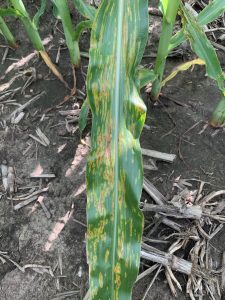Every season extension specialists and other researchers working on applied field crop pathology present data at various conferences and meetings. Often times you will view data pertaining to product efficacy and management. It is important to consider the differences between these sorts of trials when interpreting the data. Fungicides for example, are something that we discuss often, and producers are interested in understanding what to use, when to use it, and how to use it effectively and profitably.
When we want to provide data on which products perform the best for controlling a particular disease, we conduct what are known as efficacy trials. In these trials we try to obtain as much disease as possible, as it is easier to separate treatments under high disease situations. We do this through various means, usually using some combination of using susceptible varieties/cultivars/hybrids, planting into conditions favoring disease (early late planting, high plant populations), inoculating plants with the pathogen, and irrigating plots. In this way we provide an environment that favors the pathogen and disease. The result are data that may not be representative of typical conditions producers experience, and the yield protection is skewed towards extreme, highly disease favorable conditions.
There also are disease management trials. These are trials that assess how to best manage diseases under more typical situations, and often include other components of integrated pest management. These trials often use varieties/cultivars/hybrids typical to a given production region, or compare and contract plants of differing resistance levels. Cultural practices, such as planting population, row spacing, tillage, etc. are also often included. Many times these trials are not inoculated, and instead rely on natural infection. Trials conducted like this are more likely to provide a range of disease levels and yield responses more typical of what producers may experience, and when many trials are performed, inform us as to the likelihood for profitability and need to implement various management practices. However, in order to have confidence in these trials, we need many sites and years to ensure that the sample size is sufficient to capture the majority of situational variability.
When you are viewing data, keep in mind the goal of the trial and the type of trial conducted. This can help you better understand how best to make these data work for you.


